nForce 500: nForce4 on Steroids?
by Gary Key & Wesley Fink on May 24, 2006 8:00 AM EST- Posted in
- CPUs
Synthetic Graphics Performance
The 3DMark series of benchmarks developed and provided by Futuremark are among the most widely used tools for benchmark reporting and comparisons. Although the benchmarks are very useful for providing apples-to-apples comparisons across a broad array of GPU and CPU configurations, they are not a substitute for actual application and gaming benchmarks. In this sense we consider the 3DMark benchmarks to be purely synthetic in nature but still valuable for providing consistent measurements of performance.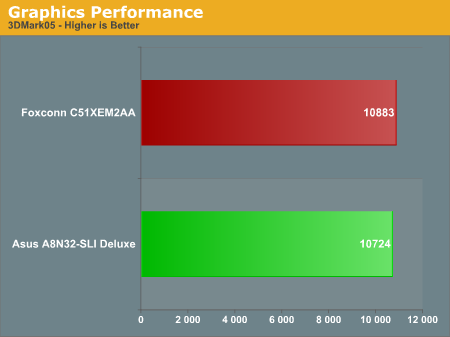
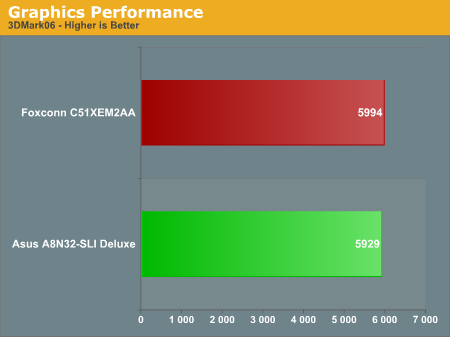
Our nForce 590 SLI system improves upon the performance of the nForce4 system by an average of 1%. These test results are basically a tie and indicates both platforms are performing equally with the same video card.
General System Performance
The PCMark05 benchmark developed and provided by Futuremark was designed for determining overall system performance for the typical home computing user. This tool provides both system and component level benchmarking results utilizing subsets of real world applications or programs. This benchmark is useful for providing comparative results across a broad array of Graphics subsystems, CPU, Hard Disk, and Memory configurations along with multithreading results. In this sense we consider the PCMark benchmark to be both synthetic and real world in nature while providing consistency in our benchmark results.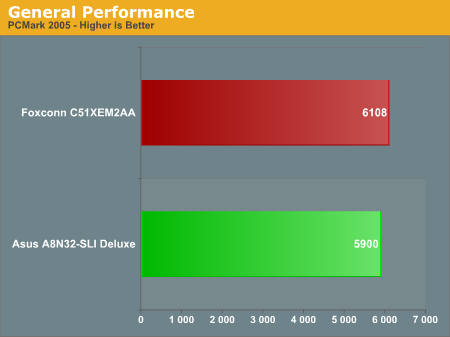
The margins are little wider at 4% in the PCMark05 results, but the margin of error in PCMark05 is also slightly larger. It is obvious from our test results so far that either platform provides excellent results. If you have a socket 939 platform and are happy with its feature set then we do not see a reason to upgrade at this time.
Rendering Performance
We have added the Cinebench 9.5 and POV-RAY 3.6 benchmarks as they heavily stress the CPU subsystem while performing graphics modeling and rendering. We utilize the standard benchmark demos in each program along with the default settings. Cinebench 9.5 features two different benchmarks with one test utilizing a single core and the second test showcasing the power of multiple cores in rendering the benchmark image.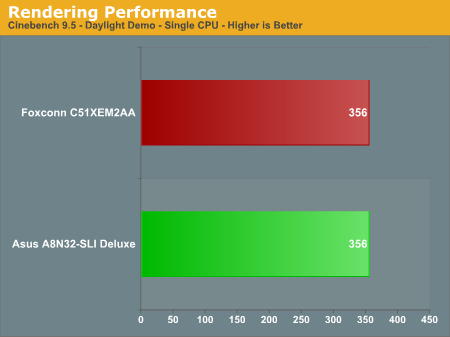
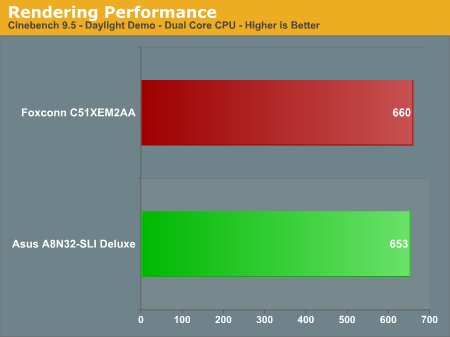
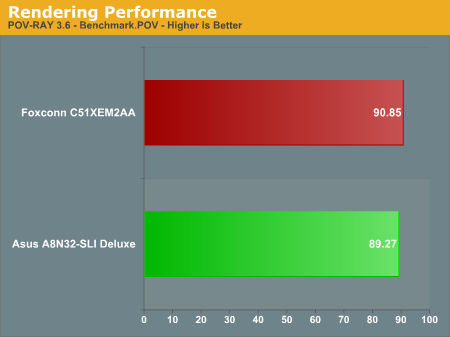
The nForce 500 desktop platform shows small and almost imperceptible differences in these benchmarks, with the 590 AM2 performing slightly better in the demanding POV-RAY benchmark. Once again both platforms are performing equally.










64 Comments
View All Comments
nullpointerus - Wednesday, May 24, 2006 - link
TCP/IP CPU utilization scales with increased transfer rates. Online gaming is hardly designed to stress a 1Gb Ethernet. So this TCP/IP acceleration is primarily intended for LAN gaming. You don't really need a firewall on your LAN (unless perhaps you are hosting a LAN party on that machine?). It's acceptable to use your router's firewall if you really know how to configure your LAN properly:Modem
|
Router
|
+--A (game server)
+--B (game client)
+--C (game client)
+--D (game client)
In this situation, TCP/IP acceleration might be useful. Of course, if you leave yourself open to your LAN and one of the other computers on your LAN is compromised, you could very well be compromised, too.
I don't understand the comments about a third-party firewall. Perhaps only XP and Vista's firewalls will be supported initially?
Trisped - Wednesday, May 24, 2006 - link
A true router can configure a firewall on all ports, both incoming and out going. In this way you can set what ports can be sent and what ports can be received through a router, in the LAN or out side as the case may be. Of course, software firewalls are usually a little more powerful in that they check who sends what. I think hardware firewalls can do this too, but they don't on any of the Linksys, Netgear, or AirLink routers I have used lately.It is also important to note that the typical home router is not a true router. It is a 2 port router (1 port for the WAN and 1 for the LAN) and the rest of the ports are connected via a switch or hub. Switches can also have firewall, but most home solutions don't seem to.
mino - Wednesday, May 24, 2006 - link
The info WHO sends teh data is the most crucial. Enabling http(80) just for Opera and 993+25 for Thundebird is a huge difference to allow al kinds of malware/spyware go out on 80.And NO, no HW (or second machine be it linux router or cisco router) can detect (reliably) which application is sending the data.
Gary Key - Wednesday, May 24, 2006 - link
I will clarify this in the article. Windows XP firewall is not supported. Vista should be but that decision is not final at this time due to continuing changes from Microsoft.
Tanclearas - Wednesday, May 24, 2006 - link
So does this mean Nvidia has abandoned AA in NF4? I know that is my impression, based upon my experience with them (http://forums.anandtech.com/messageview.aspx?catid...">http://forums.anandtech.com/messageview...mp;threa..., but just wondering what the official word is.Honestly, the idea behind Nvidia's chipset-based firewall was a good one, especially for universities/colleges with literally thousands of computers on the inside of the corporate firewall. Protection at every level is worthwhile.
As for the Vista firewall working with NF5, I definitely would not count on Nvidia making it happen.
Gary Key - Wednesday, May 24, 2006 - link
Once the new 9.x platform drivers are released with support for chipsets prior to nF5, then yes, Active Armor firewall will be dropped. The new driver set will also have further changes in them to reduce the possibility of data corruption on the nF4, whether the CPU utilization goes up or down, I do not know at this point. I do not have a "stable" set of new platform drivers for the nF4 yet, cannot verify this myself. I will be speaking with the program manager tomorrow. ;-)
We did find out that NVIDIA expected Microsoft to accomplish a few tasks in the Windows Firewall program, it did not happen, so they are pulling support as Microsoft decided to go a different direction in Vista. I have beta 2 on the way so there will be some test runs with the new driver set to see what happens. I will have a full statement on this subject by the end of the week. Apparently, there were several promises made, not kept, or not communicated properly about 18 months ago between the two parties about the Firewall program, OS hooks, and its future.
mbf - Monday, June 12, 2006 - link
Is the nVidia firewall truly gone? I've just downloaded (but not installed) the 9.34 driver pack from the nVidia FTP site. The pack still contains a NAM setup (v60.16).What exactly constitutes the ActiveArmour part of the firewall? The hardware firewall was introduced with the nForce3 250gb chipset and the AA functionality was added in nForce4. I've never figured out what precisely AA does, though.
If it's true that nVidia has pulled the firewall from the feature set I'd say it's a truly bad choice. For me, the hardware firewall was one of *the* most important features on the nForce chipset. Well, not having to wonder losing this feature will make my switch back to an Intel chipset-based Core 2 rig much easier. It's a shame.
Stele - Wednesday, May 24, 2006 - link
I was actually wondering if XP and Vista's firewalls would even be supported, since they're arguably 'third-party' from nVidia's viewpoint. While the argument for using hardware-based solutions in routers etc is cogent, imho there is a case for protecting individual PCs against compromise from within the network. For example, there may be laptops in the LAN that are used on several other (and potentially unsafe) networks as well. Besides that, software firewalls have the advantage of being able to potentially alert users to and stop malware from making unauthorised outbound connections from an infected PC (or unauthorised inbound connections from an infected LAN peer). I wonder if it's possible to get around the issue in future versions of firewall software - then at least it's not a lost cause, just that we would have to wait for newer versions of the software to be released.As for the actual usefulness of the TCP/IP offload engine, perhaps the folks at Anandtech can design a specific test that would stress such an engine's capability to the limit, to provide clear and objective assessment of its effect on performance. After all, Anandtech developed a good custom test suite for server benchmarks that targets specific application types, so I figure this would be well within their considerable programming skills as well ;)
Meanwhile, I wonder how nVidia's SATA controllers have improved if at all over the generations, and it would be great to eventually see an ULi 1575/SB600/MCP comparison in the future.
nullpointerus - Wednesday, May 24, 2006 - link
Correction:You don't really need a firewall on your LAN clients...
Gigahertz19 - Wednesday, May 24, 2006 - link
Expect the new kitchen when Conroe is launched :)